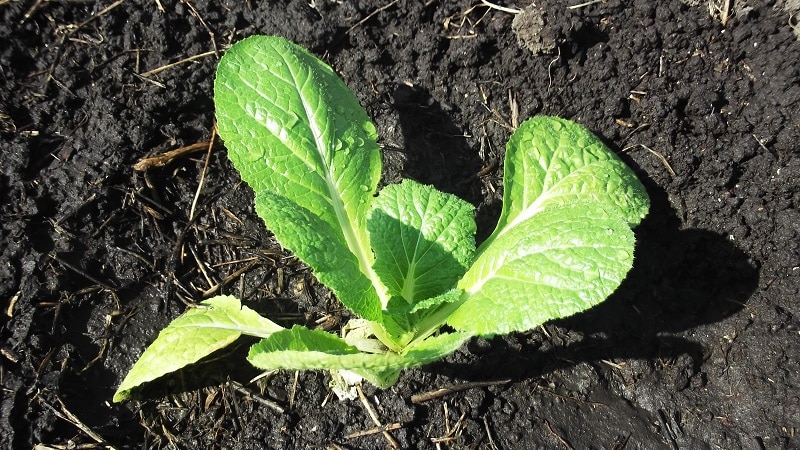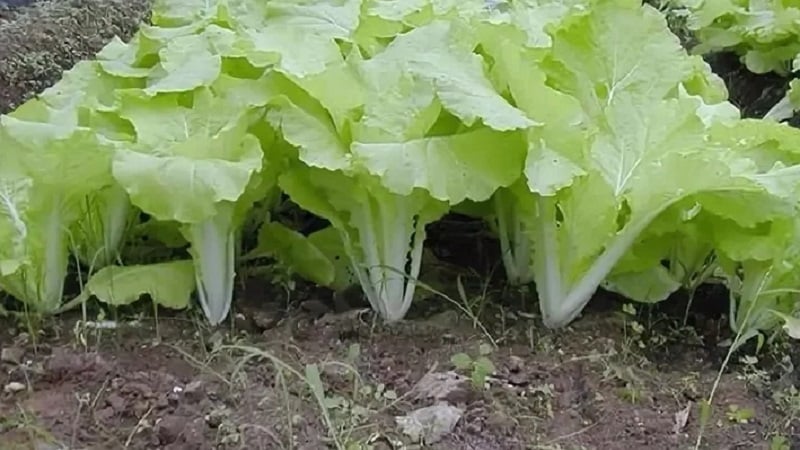How to grow Chinese cabbage in the garden in open ground and at home
Beijing (Chinese) cabbage is a plant of the Brassica family. Summer residents fell in love with this vegetable for its composition rich in vitamins and minerals and its pleasant, delicate taste. To get a good harvest of Chinese cabbage, it is important to know the rules for planting, growing and caring for it.
How to grow Chinese cabbage in a garden in open ground
Like all representatives of the species, this vegetable can be different varieties, which are divided into three groups: early-ripening, mid-ripening and late-ripening. Depending on the region, the vegetable is planted in seedlings and without seedlings.

Through seedlings, Chinese cabbage is grown in areas with cold climates, through sowing seeds in the ground - in warm climates.
Seeds for seedlings are immediately placed in separate containers, since when transplanting from a common box to a permanent place, the roots of the plant are damaged.
Seedlings grown immediately in open ground are more resistant to the development of diseases and temperature changes.
Where does Chinese cabbage grow?
Beijing cabbage is more picky about where it is grown in open ground than other representatives of the Cabbage family. To avoid bolting, early varieties are planted in shaded areas. Late ones can be grown in well-lit places, since they are planted in open ground in mid-summer, when daylight hours are already shorter.
The best predecessors of this vegetable:
- phacelia;
- legumes;
- chicory;
- potato;
- plants of the Allium family;
- tomatoes;
- celery;
- melons (melon, pumpkin, cucumbers).
This vegetable cannot be planted after other representatives of the Brassica family (turnips, radishes, radishes, rapeseed, mustard, horseradish, turnips), as they have common diseases.
Interesting things on the site:
Is it possible for a young mother to eat Chinese cabbage during breastfeeding?
How to plant Chinese cabbage
When sowing a plant for seedlings use separate containers for each seedling or peat tablets.
To grow seedlings, use ready-made store-bought mixtures or make your own soil by mixing sand and turf in a 1:1 ratio. For disinfection, wood ash is added to the soil (1 tablespoon per 1 liter of soil mixture) and spilled with a strong solution of potassium permanganate.
When sowing seeds directly into the soil experienced gardeners advise adding mineral fertilizers to it. For 1 sq. m use potassium and ammonium nitrate, 1 tbsp each. l. and superphosphate in the same proportion.
To ensure large heads of cabbage, the distance between rows is maintained at 50 cm, between seedlings - 30 cm.
At what temperature does it grow and is it afraid of frost?
Chinese cabbage ripens quickly, so it is planted several times per season.. For the first seedlings, seeds are sown in March and April, the second time - in July and August.

Also The timing of planting vegetables in open ground depends on the region:
- in the southern regions, seeds for seedlings are sown at the end of February, the second time - at the end of August;
- in Siberia and the Urals - at the end of March, again - at the end of July;
- in the middle zone and Moscow region - in the second half of April, the second time - in early August.
Chinese cabbage is a heat-loving plant, so the optimal temperature for seedlings will be +22°C. To plant in a permanent place, the soil must warm up to +15°C, the air - up to +20°C.
Important! Vegetable seedlings do not tolerate low temperatures well and fade or die if they are kept at temperatures below +13°C for a long time.
Ripening and growing season
In agricultural technology, Chinese cabbage is considered an early ripening vegetable. The growing season depends on the type of vegetable:
- for early ripening it is 35-50 days;
- for mid-season - 55-80 days;
- for later ones – from 70 days.
Early and mid-season types of Chinese cabbage are recommended to be eaten immediately after ripening, as they are bad are stored. Late varieties retain their taste for 3-6 months.
Caring for Chinese cabbage
The technology for growing Chinese cabbage includes timely watering and fertilizing with mineral and organic fertilizers.
Watering
Water Chinese cabbage with warm water. In dry weather - once every 3-4 days, in rainy weather - once every seven days. In case of heavy precipitation, the vegetable does not need additional moisture.
Necessarily based on soil moisture, since more than 65% can lead to rotting of the vegetable root.
Important! Water Chinese cabbage only at the root, since water that gets on the leaves causes them to burn.
Top dressing
To obtain a good harvest, the plant feed several times a season. Fertilizers are applied for the first time 14 days after planting in a permanent place. To do this, use one of the following solutions:
- mullein infusion (1 kg per 10 liters of water);
- product made from bird droppings (500 g per 10 liters of water);
- nitroammophoska (1 tsp per 10 liters of liquid).
Organic fertilizers are applied 1 liter per bush, mineral – 10 l per 1 sq. m.
The second and third dressings are applied at equal time intervals, making up 14 days. The following means are used for this:
- wood ash (200 g per 10 l);
- boric acid solution (2 g per 10 l).
Early varieties planted in well-fertilized soil, do not need additional feeding.

Is it possible to pick Chinese cabbage?
Seedlings of this plant do not tolerate transplantation well., so the seeds are sown in separate pots or peat tablets. Seedlings grown in a common box do not take root well when transplanted and may die.
Seedlings are planted in separate containers according to the following algorithm:
- wait for 2-3 true leaves;
- thoroughly drain the soil in the box and containers for replanting;
- Using a spatula, carefully remove the seedling;
- place it in a separate container, deepening it into the soil up to the cotyledon leaves;
- compact the soil around the plant;
- place on the windowsill, protected from direct sunlight.
Only healthy, strong seedlings are replanted.
Take note:
How to grow Chinese cabbage at home
Chinese cabbage is successfully grown not only in the garden, but also at home on the windowsill. For this, there are special early hybrids that produce a harvest within a month after planting the seeds.
Growing from seeds on a windowsill
To harvest Chinese cabbage on the windowsill early half-headed and leaf varieties are suitable. These include:
- Ibinskaya;
- Lenok;
- Half-headed;
- TSHA 2;
- Stonefly;
- Broadleaf.
The growing season of such species varies from 30 to 60 days. They are characterized by increased resistance to diseases and stress resistance.

How to properly plant in jars
Ready-made biosoil is used for planting, which includes vermiculite, vermicompost and lowland peat, or prepare the soil yourself. To do this, mix humus, sand, and garden soil in proportions 2:1:1. Then the mixture is disinfected with boiling water, a strong solution of manganese or “Fitosporin” (1 drop per 1 liter).
Plant the seeds in separate pots, which must have drainage holes. Landing occurs according to the following algorithm:
- Pour soil into pots.
- Sprinkle with warm water.
- Plant the seeds to a depth of 5-10 mm.
- Sprinkle with a small layer of soil.
- Spill again.
- Cover the container with glass or plastic wrap.
- Place containers in a warm place (+20…+25°C).
- After the sprouts appear, on days 3-5, remove the cover and place the pots on the windowsill, protecting the seedlings from direct sunlight.
There is no need to fertilize Chinese cabbage grown on a windowsill., since it will have enough nutrients contained in the soil.
Basic rules for planting Chinese cabbage in autumn (before winter)
Chinese cabbage is planted in the soil not only in spring, but also in autumn.. The main condition is the correct choice of seeds. Mid-season and late varieties tolerate winter cold best.
Seeds are planted in the soil when Stable cold weather has already set in and there is no danger of premature shoots appearing. The soil is prepared in advance. The ridge is dug up with a shovel full and the same fertilizers are applied to the soil as when planting in the spring.
Then make grooves 2-5 cm deep and cover the bed with thick plastic film. When stable cold weather sets in, the seeds are placed in holes, covered with soil and compacted well.
Important! Before autumn planting, the seeds are not treated with growth stimulants and are not soaked.
In spring, seedlings must be protected from frost. using a special covering material or greenhouse film. After the plants get stronger, they are thinned out.
For added protection Chinese cabbage plantings are mulched with straw, hay or sawdust.
Conclusion
Chinese cabbage is one of the most finicky vegetables of the Brassica family. But if you follow all the growing rules, timely watering and fertilizing, you can get a good harvest several times a season.